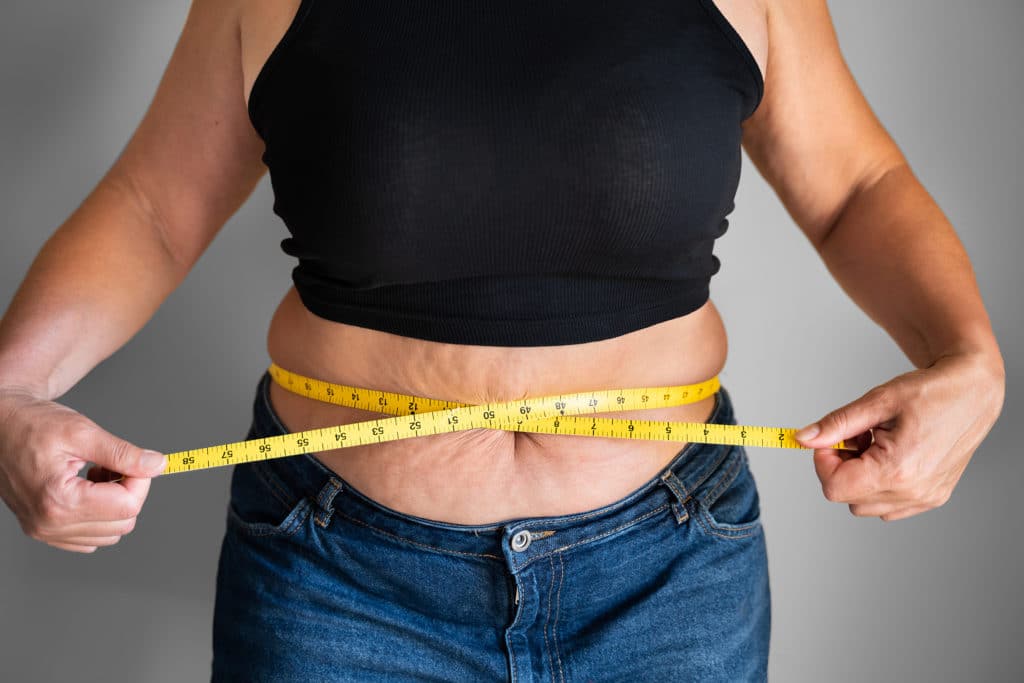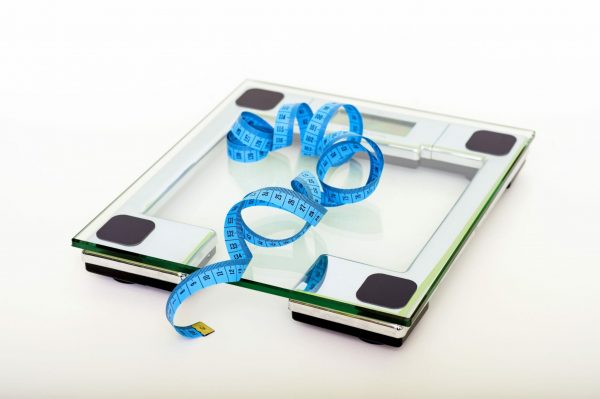8 Ways To Beat Menopausal Belly Fat

You’ve put on weight around your belly and it won’t budge no matter what you do. All this, even though you’re using your ‘tried-and-tested-through-the-years’ method.
It’s frustrating and it’s disempowering. But take heart. We’re here to tell you how to lose belly fat.
At MenoMe we know that weight gain is a huge issue for some of you. In particular, we’re referring to belly fat or what is also known as ‘meno belly’.
So before we go any further, let’s start by saying, ‘‘we hear you’’ – and follow that up with the good news that there is a lot you can do about it.
One question we hear frequently is ‘‘Does menopause weight gain go away?’’ And the answer to that is: it definitely can.
Menopause is not a calling card for excessive weight gain and for your health it shouldn’t be. Especially when we’re talking belly fat (more on this later).
However, it can highlight the need to work on hormone balance. Gaining weight and difficulty losing it can often be attributed to hormonal imbalance. These imbalances can include insulin resistance, leptin resistance, estrogen dominance, excess cortisol and thyroid dysfunction.
In addition, as we grow older we lose lean muscle mass and metabolism naturally slows down. Consequently, we need fewer calories to maintain our usual weight.
Your Body Shape Will Change
Once your body begins to go through changes in perimenopause through into post-menopause, your body shape will change.
As you may know, the menopause years ultimately culminate in a decline in estrogen. When you’re younger one of estrogen’s roles is to deposit fat onto your hips. However, as it diminishes this action shifts to the tummy area. It’s part of our evolutionary makeup and why we tend to move from an hourglass or pear shape to an apple shape.
Just as your shape is hardwired to alter during puberty and pregnancy, it’s in your DNA for it to change at menopause. If you’re a post-menopausal woman and you feel your body looks markedly different from when you were younger, it probably does. It’s normal and natural.
A change in shape, a couple more kilograms and a little more belly fat are to be expected. Research shows that on average, a woman will gain 1-2.5kg during menopause.
However, that’s not to say that an excess of any of these is something you should take in your stride, because then it can become a health concern.
Surplus weight can lead to a risk of conditions such as obesity, type 2 diabetes, cardiovascular disease and post-menopausal breast cancer.
Does Menopause Weight Gain Go Away?

Weight gain rarely goes away on its own although there is plenty you can do to mitigate it.
But it’s not as simple as ‘calories in versus calories out’ or ‘eat less, exercise more‘. In fact, the opposite is true. It’s a mistake to try and starve yourself or embark on an extreme exercise regime as these practices may cause you to gain weight.
While many women attempt to deal with ‘meno belly’ by eating less or taking up intense exercise, it can be counterproductive. Your body is already going through massive changes during menopause so these actions contribute to the release of the stress hormone, cortisol. Furthermore, they can also contribute to insulin resistance* and leptin resistance**.
When insulin or leptin resistance is present and/or cortisol levels are too high, it deposits fat in your belly. It can also lead to hunger and cravings for refined carbohydrates and sugary foods. Moreover, cortisol is geared towards human survival, so it will do everything in its power to hold onto that fat.
The key to beating belly fat lies in nourishing your body, moving in a healthy way and minimising stress.
*Insulin resistance: insulin is known as the fat-storage hormone. It controls our blood sugar and its role is to escort fuel from food to the cells of the body to be used for energy. However, over time a highly refined diet can cause the cells to become too resistant to accommodate insulin. So it goes on to store the fuel as fat.
** Leptin resistance: leptin is often called the satiety hormone. When it’s working well it sends a message to the brain that we have eaten enough. (Its sister, known as grehlin or the hunger hormone, lets the brain know to tell us that we’re hungry.)
The Composition of Belly Fat
Belly fat is different from other types of fat as it can be made up of two varieties:
1. Subcutaneous fat: the visible kind that sits just under the skin.
2. Visceral fat: this sits around the internal organs. It can amplify issues like insulin resistance, elevated cortisol and high blood sugar. Visceral fat is also implicated in cardiovascular disease, dementia, breast and bowel cancer, type 2 diabetes and stroke.
8 Ways To Counter Belly Fat aka Meno Belly

NB: don’t get too caught up in all the ‘diets’ out there. Science shows there is no one size fits all, although some recommendations apply to many of the more sensible regimens. These include eating unprocessed foods, lean proteins and healthy fats, and ditching processed foods. Overall, the Mediterranean Diet is consistently a winner for menopausal women, both for relieving symptoms and weight management. What’s more, it’s very safe and has been found to be sustainable in the long term.
1. Love Your Gut
The reason you’re hearing so much more about gut health these days is because we know more about it. Way more than we did 10 years ago. You may have learned that our digestive system is home to trillions of bacteria also known as microbiome, microbiota and gut flora. These are made up of a mix of good and bad bugs and we need to keep them in a healthy balance. And that balance has a large role to play in weight management. The good guys help us digest and metabolise our food. They flourish with fibre from foods like fresh vegetables and whole grains. Also, if you don’t have a histamine intolerance, fermented foods like sauerkraut.
2. Enjoy More Vegetables
When it comes to menopause, it’s all about ingesting the most nutrition that you can. Vegetables are literal nutrient powerhouses loaded with gut-loving fibre. Furthermore, cruciferous vegetables such as broccoli, cabbage, Brussels sprouts and kale contain a compound known as DIM. DIM can help balance estrogen, decrease inflammation and protect against hormone-dependent breast cancer.
3. Eat Less Sugar
There is a myriad of reasons for eating less refined sugar when it comes to waging war on belly fat. It’s a prime contributor to insulin and leptin resistance and the bad guys in our digestive system adore it. You can read more in our sugar series here.
4. Load Up On PPFF (whole foods, phytoestrogens, protein, fat & fibre)
Choosing food that is as untampered with by science as possible is a good overarching rule to live by. Likewise, we need building blocks for hormones. These include omega-3 essential fatty acids and healthy fats from wild salmon, walnuts, hemp seed oil, avocados and extra virgin olive oil. Lean protein like beans, peas, lentils, cottage cheese and poultry keeps our blood sugar stable, which makes it easier to lose weight. As well as this, prebiotic foods like onions, garlic, lentils, flaxseeds and oats promote gut health. Also beneficial are phytoestrogens that mimic our natural estrogen, including flax and sesame seeds, soy foods such as tofu/edamame beans and cruciferous vegetables. Download our free phytoestrogen list here.
5. Know That The (Right) Type Of Carbs Are Not The Enemy
We need them for fuel and they’re one of the three essential macronutrients: protein, fat and carbohydrates. With that said, be aware that refined carbs like potato chips, white bread, pasta and sugar-filled ‘treats’ feed the gut’s bad bugs. Stripped of fibre and nutrients in the manufacturing process, the body burns them very quickly, thereby rapidly spiking blood sugar. In turn, this encourages mood swings, energy fluctuations and the accumulation of belly fat.
Ultimately, it becomes a vicious cycle, because eating these foods causes you to crave more. So when it comes to carbohydrates, it’s essential to choose complex carbs such as beans, peas, sweet potatoes and whole grains.
And remember, less is more when it comes to weight loss. An easy guideline is to load up half your plate with vegetables, a quarter with protein, and an eighth each healthy fat and carbohydrate.
6. Diarise stress management daily
The term ‘stress’ is liberally sprinkled through conversations these days; it’s part of life and some of it’s a good thing. However, it’s crucial to balance it during menopause because lower estrogen and higher cortisol are quintessential factors. Therefore, it’s vital that cortisol doesn’t go sky high. If it does, it will worsen sleep problems, brain fog, anxiety, headaches, mood swings, digestive disturbances and weight gain.
Mindfulness, meditation and yoga have all been scientifically proven to help reduce stress during menopause. There are some excellent apps available to help too, including the Clarity app, Headspace and Calm. Nature bathing or spending time outdoors is being looked at as a therapy to help with the modern-day ‘stress-state’’.
7. Prioritise hormone balance

With a high percentage of weight gain and weight loss resistance pointing to hormone imbalance as a contributor, this point is a no brainer. One of the fundamental characteristics of menopause is hormonal fluctuation. At MenoMe, we have 40+ and 55+ to help you do this naturally and safely in combination with the above tools. In addition, avoiding hormone disruptors such as pesticides and chemicals in food and cleaning products is recommended.
A Quick Note On Exercise
Eighty-ninety per cent of weight gain and management is about what you do in the kitchen. Nevertheless, moving your body is vital to help you build muscle, metabolise energy, and improve your sleep and mental health.
Yoga, Pilates, resistance/weight training all have proven benefits with the bonus of being well-known mood enhancers. Using resistance whether that be via bodyweight or weights also increases bone density and metabolism.
HIIT (High-Intensity Interval Training), which alternates intense bursts of exercise with rest periods has also been found to be beneficial for midlife women. It doesn’t prolong raised cortisol in the same way as a run would. Weight training also increases bone density and metabolism. This study found HIIT helpful for reducing abdominal/visceral fat in post-menopausal women. And this research showed weight loss and exercise lowered dangerous forms of serum estrogen. As such, it can be protective against breast cancer in post-menopausal women.
Bringing It All Together
Midlife weight gain and belly fat are complicated. There are many moving parts, some of which we’ve covered here.
This is a good starting point because weight loss is important for how you feel and crucial for your health. Choose one or two of these ideas to implement over the next week or two and see how you go.
Have you got any questions or do you need more help? Don’t hesitate to contact me here.









